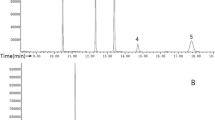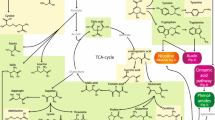Abstract
This report presents a simple, rapid and accessible validated method for quantification of eight major plant growth regulators (PGR): cytokinins (6-(γ,γ-dimethylallylamino)purine (2-iP), benzylaminopurine (BA) and zeatin), auxin (indole-3-acetic acid; IAA), jasmonic acid (JA), salicylic acid (SA), gibberellic acid (GA3) and abscisic acid (ABA) by liquid chromatography mass spectrometry. This method was tested in eight species including agricultural, ornamental and medicinal species: St. John’s wort, African violet, banana, American elm, tobacco, potato, sweet wormwood, and fennel. The method has good reproducibility and good sensitivity with %RSD (percent relative standard deviation) between 1 and 10% for all matrices and recovery values of 89 to 118% for all analytes. Method detection limits were 50.65 ng/g, 203.4 ng/g, 50.65, ng/g, 50.65 ng/g, 203.4 ng/g, 12.7 ng/g, 193 pg/g and 3.08 ng/g, for SA, IAA, zeatin, JA, GA3, ABA, 2-iP, and BA, respectively. Our results with a range of plant species show that this method represents a simple, low-cost method for analysis of PGRs, and may also serve as an useful starting point for the analysis of other related PGRs, as demonstrated by inclusion of the SA derivative, acetylsalicylic acid, and the JA derivatives: 12-oxo-phytodienoic acid and JA-isoleucine. The efficiency of this method will enable its incorporation into the plant tissue culture work flow and through characterization of endogenous PGR levels, will allow for improved method development for recalcitrant species facilitating fundamental and applied studies in plant morphogenesis, propagation and conservation.




Similar content being viewed by others
Abbreviations
- ABA:
-
Abscisic acid
- ASA:
-
Acetylsalicylic acid
- BA:
-
6-Benzylaminopurine
- 2,4-D:
-
2,4-Dichlorophenoxyacetic acid
- GA3:
-
Gibberellic acid
- IAA:
-
Indole-3-acetic acid
- 2-iP:
-
6-(γ,γ-dimethylallylamino)purine
- JA:
-
Jasmonic acid
- JA-Ile:
-
Jasmonic acid isoleucine
- MeOH:
-
Methanol
- MS:
-
Mass spectrometry
- OPDA:
-
12-Oxo-phytodienoic acid
- PCIB:
-
p-Chlorophenoxyisobutyric acid
- PGR:
-
Plant growth regulator
- %RSD:
-
Percent relative standard deviation
- SA:
-
Salicylic acid
- SIR:
-
Single ion recording
- SJW:
-
St. John’s wort
- SLV:
-
Single lab validation
- TIBA:
-
2,3,5-Triiodobenzoic acid
- TDZ:
-
Thidiazuron
- UPLC:
-
Ultra-performance liquid chromatography
References
AOAC International (2013) Appendix K: Guidelines for dietary supplements and botanicals. In: Official methods of analysis. AOAC International, Arlington, Appendix K: 1–32
Arteca RN (1996) Manipulation of growth and photosynthetic processes by plant growth regulators. In: Plant growth substances. Springer, Boston, pp 240–272
Assani A, Chabane D, Foroughi-Wehr B, Wenzel G (2006) An improved protocol for microcallus production and whole plant regeneration from recalcitrant banana protoplasts (Musa spp.). Plant Cell Tissue Organ Cult 85:257–264. doi: 10.1007/s11240-005-9058-y
Betz JM, Brown PN, Roman MC (2011) Accuracy, precision, and reliability of chemical measurements in natural products research. Fitoterapia 82:44–52. doi: 10.1016/j.fitote.2010.09.011
Bliesner DM (2005) Validating chromatographic methods: a practical guide. Wiley, Hoboken
Bonga JM, Klimaszewska KK, von Aderkas P (2010) Recalcitrance in clonal propagation, in particular of conifers. Plant Cell Tissue Organ Cult 100:241–254. doi: 10.1007/s11250-009-9647-2
Bu X, Regalado EL, Hamilton SE, Welch CJ (2016) The emergence of low-cost compact mass spectrometry detectors for chromatographic analysis. Trends Anal Chem 82:22–34. doi:10.1016/j.trac.2016.04.025
Cai B-D, Ye E-C, Yuan B-F, Feng Y-Q (2015) Sequential solvent induced phase transition extraction for profiling of endogenous phytohormones in plants by liquid chromatography-mass spectrometry. J Chromatogr B 1004:23–29. doi: 10.1016/j.jchromb.2015.09.031
Cutler AJ, Saleem M, Coffey MA, Loewen MK (1989) Role of oxidative stress in cereal protoplast recalcitrance. Plant Cell Tiss Org Cult 18:113–127. doi:10.1007/BF00033470
Enders TA, Strader LC (2015) Auxin activity: past, present, and future. Am J Bot 102:180–196. doi: 10.3732/ajb.1400285
Gantait S, Sinniah UR, Ali MN, Sahu NC (2015) Gibberellins—a multifaceted hormone in plant growth regulatory network. Curr Protein Pept Sci 16:406–412. doi: 10.2174/1389203716666150440125439
Gaspar T, Kevers C, Penel C, Greppin H (1996) Plant hormones and plant growth regulators in plant tissue culture. In Vitro Cell Dev Biol Plant 32:272–289
Hewezi T, Jardinaud F, Alibert G, Kallerhoff J (2003) A new approach for efficient regeneration of a recalcitrant genotype of sunflower (Helianthus annuus) by organogenesis induction on split embryonic axes. Plant Cell Tissue Organ Cult 73:81–86. doi:10.1023/A:1022689229547
Holopainen JK, Blande JD (2012) Molecular plant volatile communication. Adv Exp Med Biol 739:17–31. doi: 10.1007/978-1-4614-1704-0_2
Huang G-T, Ma S-L, Bai L-P et al (2012) Signal transduction during cold, salt, and drought stresses in plants. Mol Biol Rep 39:969–987. doi: 10.1007/s11033-011-0823-1
Hutchinson MJ, Saxena PK (1996) Acetylsalicylic acid enhances and synchronizes thidiazuron-induced somatic embryogenesis in geranium (Pelargonium × hortorum Bailey) tissue cultures. Plant Cell Rep 15:512–515. doi: 10.1007/BF00232984
Jones AMP, Shukla MR, Biswas GCG, Saxena PK (2014) Protoplast-to-plant regeneration of American elm (Ulmus americana). Protoplasma 252:925–931. doi: 10.1007/s00709-014-0724-y
Kaur P, Kothari SL (2004) In vitro culture of kodo millet: anfluence of 2,4-D and picloram in combination with kinetin on callus initiation and regeneration. Plant Cell Tissue Organ Cult 77:73–79. doi: 10.1023/B:TICU.0000016505.20448.44
Li H, Murch SJ, Saxena PK (2000) Thidiazuron-induced de novo shoot organogenesis on seedlings, etiolated hypocotyls and stem segments of Huang-qin. Plant Cell Tissue Organ Cult 62:169–173. doi: 10.1023/A:1006491408762
Li G, Lu S, Wu H et al (2015) Determination of multiple phytohormones in fruits by high-performance liquid chromatography with fluorescence detection using dispersive liquid-liquid microextraction followed by precolumn fluorescent labeling. J Sep Sci 38:187–196. doi: 10.1002/jssc.201401131
Mithila J, Hall J, Victor JMR, Saxena P (2003) Thidiazuron induces shoot organogenesis at low concentrations and somatic embryogenesis at high concentrations on leaf and petiole explants of African violet (Saintpaulia ionantha Wendl.). Plant Cell Rep 21:408–414. doi: 10.1007/s00299-002-0544-y
Moubayidin L, Di Mambro R, Sabatini S (2009) Cytokinin–auxin crosstalk. Trends Plant Sci 14:1360–1385. doi: 10.1016/j.tplants.2009.06.010
Mundhara R, Rashid A (2006) Recalcitrant grain legume Vigna radiata, mung bean made to regenerate on change of hormonal and cultural conditions. Plant Cell Tissue Organ Cult 85:265–270. doi: 10.1007/s11240-005-9061-3
Murch SJ, Saxena PK (2001) Molecular fate of thidiazuron and its effects on auxin transport in hypocotyls tissues of Pelargonium × hortorum Bailey. Plant Growth Regul 35:269–275. doi:10.1023/A:10144689059593
Murch SJ, Liu C, Romero RM, Saxena PK (2004) In vitro culture and temporary immersion bioreactor production of Crescentia cujete. Plant Cell Tissue Organ Cult 78:63–68. doi:10.1023/B:TICU.0000020397.01895.3e
Murthy B, Murch SJ, Saxena PK (1998) Thidiazuron: a potent regulator of in vitro plant morphogenesis. In Vitro Cell Dev Biol Plant 34:267–275. doi 10.1007/BF02822732
Murthy HN, Hahn EJ, Paek KY (2008) Recurrent somatic embryogenesis and plant regeneration in Coriandrum sativum L. Sci Hortic 118:168–171. doi: 10.1016/j.scienta.2008.05.037
Nguyen AH, Hodgson LM, Erskine W, Barker SJ (2016) An approach to overcoming regeneration recalcitrance in genetic transformation of lupins and other legumes. Plant Cell Tissue Organ Cult 127:623–635. doi: 10.1007/s11240-016-1087-1
Pan X, Welti R, Wang X (2010) Quantitative analysis of major plant hormones in crude plant extracts by high-performance liquid chromatography-mass spectrometry. Nat Protoc 5:986–992. doi: 10.1038/nprot.2010.37
Pliego-Alfaro F, Monsalud MJR, Litz RE, Gray DJ, Moon PA (1996) Effect of abscisic acid, osmolarity and partial desiccation on the development of recalcitrant mango somatic embryos. Plant Cell Tissue Organ Cult 44:63–70. doi: 10.1007/BF00045914
Sanago MH, Murch SJ, Slimmon TY, Krishnaraj S, Saxena PK (1995) Morphoregulatory role of thidiazuron: morphogenesis of root outgrowths in thidiazuron-treated geranium (Pelargonium × hortorum Bailey). Plant Cell Rep 15:205–211. doi: 10.1007/BF00193721
Sherif S, Jones A, Shukla MR, Saxena PK (2014) Establishment of invasive and non-invasive reporter systems to investigate American elm–Ophiostoma novo-ulmi interactions. Fungal Genet Biol 71:32–41. doi: 10.1016/j.fgb.2014.08.005
Sherif SM, Shukla MR, Murch SJ et al (2016) Simultaneous induction of jasmonic acid and disease-responsive genes signifies tolerance of American elm to Dutch elm disease. Sci Rep 6:21934. doi: 10.1038/srep21934
Shukla MR, Jones AMP, Sullivan JA et al (2012) In vitro conservation of American elm (Ulmus americana): potential role of auxin metabolism in sustained plant proliferation. Can J For Res 42:686–697. doi: 10.1139/x2012-022
Skoog F, Miller CO (1957) Chemical regulation of growth and organ formation in plant tissues cultured in vitro. Symp Soc Exp Biol 11:118–130
Song S, Qi T, Wasternack C, Xie D (2014) Jasmonate signaling and crosstalk with gibberellin and ethylene. Curr Opin Plant Biol 21:112–119. doi: 10.1016/j.pbi.2014.07.005
Werner T, Schmülling T (2009) Cytokinin action in plant development. Curr Opin Plant Biol 12:527–538. doi: 10.1016/j.pbi.2009.07.002
Xu X, Xie G, He L, Zhang J, Xu X, Qian R, Liang G, L J-H (2013) Differences in oxidative stress, antioxidant systems, and microscopic analysis between regenerating callus-derived protoplasts and recalcitrant leaf mesophyll-derived protoplasts of Citrus reticulata Blanco. Plant Cell Tissue Organ Cult 114:161–169. doi: 10.1007/s11240-013-0312-4
Acknowledgements
The authors gratefully acknowledge the financial support of this work by the National Sciences and Engineering Research Council (NSERC) of Canada [Grant Number 46741] and the Gosling Research Institute for Plant Preservation (GRIPP) [Grant Number 050294].
Author information
Authors and Affiliations
Contributions
LAEE participated in conception and design, data acquisition, analysis and interpretation, MRS participated in conception and design, WBG participated in conception and design and data analysis and PKS participated in conception and design and data interpretation. All authors participated in manuscript preparation and gave final approval of the manuscript.
Corresponding author
Ethics declarations
Conflict of interest
The authors declare no conflict of interest.
Additional information
Communicated by Pamela J. Weathers.
Rights and permissions
About this article
Cite this article
Erland, L.A.E., Shukla, M.R., Glover, W.B. et al. A simple and efficient method for analysis of plant growth regulators: a new tool in the chest to combat recalcitrance in plant tissue culture. Plant Cell Tiss Organ Cult 131, 459–470 (2017). https://doi.org/10.1007/s11240-017-1297-1
Received:
Accepted:
Published:
Issue Date:
DOI: https://doi.org/10.1007/s11240-017-1297-1




